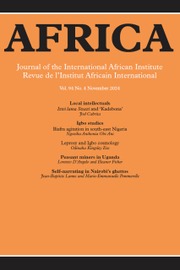Nations as imagined communities are not forged exclusively by language, common origins, myths and visions. The enactment of national rituals and selected symbols that accompany such rituals tend to reinforce citizens’ sentiments of belonging. In The Lion and his Pride, Kathrin Tiewa reflects on the significance of national holidays as framed ceremonials where state symbols are exhibited, contested and celebrated. She also demonstrates in considerable detail how this played out in Cameroon as the country commemorated the fiftieth anniversary of its independence from colonial rule. Combining archival sources, interviews, textual analysis and ethnographic methods, Tiewa weaves a superb account of the tensions and controversies that surrounded the staging of Cameroon's Golden Jubilee.
Cameroon is a complex postcolonial state that has struggled with efforts to forge a nation out of its considerable ethnic and linguistic diversity, including two enduring colonial legacies – French and English. In commemorating its Golden Jubilee or Cinquantenaire, Tiewa contends that the Cameroon government ‘staged the idea of unity in a variety of cultural and political events during the jubilee celebrations’ (p. 18) between 2010 and 2011 and that these events prioritized and celebrated francophone hegemony over anglophone counterparts – in a show of sheer power and deliberate forgetting (p. 19). The organizers, made up exclusively of Paul Biya's ruling party members or bureaucrats, ‘avoided the commemoration of conflict-ridden moments of the history of the country in order to prevent past controversies from re-awakening’ (p. 16). But these past controversies have never really gone away because successive regimes have refused to address them in productive ways – hence the reason why a civil war is raging in the anglophone regions.
Tiewa convincingly argues that the trope of unity during these celebrations was not ‘only used to celebrate the ruling government's achievements in order to support Biya's electoral campaign, but also to divert attention from existing problems such as the “unity question”’ (p. 19). Cameroon evolved from a federation established in 1961 between the two former UN trust territories – British Southern Cameroons and French Cameroon – through a ‘united’ phase between 1972 and 1984 and since then to what government officials refer to as a ‘one and indivisible’ nation. In 2010, the celebrations were anchored around the so-called peaceful revolution that ushered in the unitary state in 1972 (p. 122). However, anglophone activists decry this date and the events surrounding it as the period when the federation they agreed on with their francophone counterparts met its demise. To this end, neither 1 January 1960 (the actual date of French Cameroon's independence) nor 1 October 1961 (the date of British Southern Cameroons’ independence) featured as reference points for the Golden Jubilee celebrations, but rather 20 May 1972. Thus, it is plausible that the Golden Jubilee was staged in order to impose the francophone-dominated government's version of historical truth by emphasizing the significance of ‘unity’ over the celebration of fifty years of independence (p. 65).
In elaborating this myth of unity, Tiewa shows how the rituals of commemoration were performed in a variety of contexts and processes – in presidential speeches, the unveiling of an official logo, the official wax print cloth, commemorative stamps (with Biya's face on the highest-priced edition) and the renaming of sites in honour of either Biya or the Golden Jubilee.
Tiewa's work is marred by a range of methodological flaws and historical inaccuracies. I find it intriguing that whereas she and her assistants carried out surveys in the towns and cities where the jubilee events were staged and quantitative data provided (p. 183), no such surveys are reported about the events that were later staged in Bamenda (December 2010) and Buea (February 2014). Similarly, there is no evidence in this work that she stationed assistants in either Buea or Bamenda on 20 May 2010 to document how Golden Jubilee activities were unravelling. Would not the myth of unity have been made more apparent and her analyses strengthened by data from the anglophone regions of the country? In privileging data obtained not only from predominantly francophone cities but by francophone research assistants – who mostly conducted their research in French, even in the anglophone provinces – doesn't her work inadvertently further the sort of francophone hegemonic machinations she seeks to critique? Furthermore, these methodological gaps raise concerns about the data's validity, particularly as the assistants not only helped in gathering data but were interviewees themselves, with very limited knowledge of Southern Cameroons’ history. Other concerns rest on many historical or factual inaccuracies – more than I can list in this review. For instance, Tiewa states that the main opposition party, the Social Democratic Front (SDF), boycotted the presidential elections of October 1992 (p. 186) – arguably the most controversial election in the post-1990 multiparty era because the SDF candidate, John Fru Ndi, is widely believed to have won despite the official outcome. She also inaccurately submits that Ephraim Inoni succeeded Achidi Achu as prime minister (p. 186) and that, during the 2007 parliamentary elections, the Cameroon People's Democratic Movement gained eight seats, bringing the ‘total number to nine in the regional parliament’ (p. 186) in a country where no regional parliament exists.
These flaws notwithstanding, Tiewa has added to our knowledge of the politics of commemoration and specifically how national rituals validate the body politic – or, in Cameroon's case, expose the deepening fissures. For students and scholars of Cameroon politics who missed the 2010 Golden Jubilee celebrations, this book has meticulously documented for posterity and analysed the events as they unfolded. It will also be a vital resource in comparative studies of political ritual and commemoration in postcolonial societies where nation-building efforts have either suffered setbacks or been undermined by poor governance and prolonged dictatorship.



